
9 Interesting Facts about Oriental and Persian Rugs
We love to take care of your Oriental and Persian rugs! Here at Persian Rug Cleaner, we live and breathe the care and upkeep of your beautiful rugs. That said, we’re true “rugophiles.” Talk to us at parties and we’ll talk your ears off about handmade rugs.
9 interesting facts to help you identify fine quality rugs
1. Oriental and Persian rugs often are referred to interchangeably but they are very different. Strictly speaking, Oriental rugs are those that are knotted by hand in Asia, Iran, India, Russia, China, Turkey, Pakistan, Nepal, and Turkey, while Persian rugs are created by fine craftspeople only in Iran (which used to be known as Persia).
2. Persian rug designs once were named after the city in which they were created but as their popularity increased, these designs started to be produced elsewhere. Still, they retain their original names. Some of the most popular designs are Tabriz, Mashad, Isfahan, Nain, Sarouk, Shiraz, Heriz.
3. Persian rugs can be identified by their very thick (usually so) pile of up to 160 to 200 knots per square inch for an average quality rug and 1,500 and higher for higher quality rugs. They are also known for their exceptional and unique designs and rich combination of color.
4. The beauty of these rugs comes from the balance and harmony of the rugs’ colors, the intricacy, and clarity of their designs, their texture, and the patina of their yarns and the workmanship of weaver.
5. If you come across rugs that are termed “Oriental style,” or “Persian design, “ they are often not handmade/ hand-knotted rugs, they are hand tufted or loomed by machine rugs. If a machine-loomed rug is called an Oriental or Persian rug, the seller and/or manufacturer is misleading you. Only hand-knotted rugs are true Oriental or Persian rugs.
6. It is a myth that the heavier the rug is, the more durable it is. This is not necessarily the case, many variables go into how much any rug ultimately weighs: the pile lengths of its wool fibers, the diameter of its yarns, and the number of plies, all of these factors determine a rug’s finished weight. In general finer rugs are very thin.
7. Any hand-knotted rug will have irregularities within its weave/pattern/design. Humans are fallible and even the finest of weavers and knitters will make mistakes.
8. The knot count in a handmade rug of these styles may range between 50 to 1500 per square inch.
9. A large percentage of Oriental and Persian Rugs – so long as they are truly well-made and well-cared for- will increase in value over time.
If you are wondering if the rug you purchased or were gifted is a truly handwoven Oriental or Persian rug, we will be happy to take a look at it. Call to set up a time for an evaluation or insurance-grade written appraisal. Verbal appraisals are free.
All Persian and Oriental rugs should be professionally washed every 3 to 5 years.

